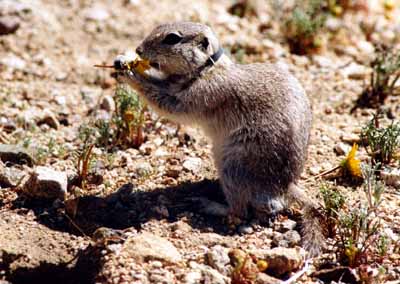Mohave Ground Squirrel (Spermophilus mohavensis)

About 9 inches from nose to tip of tail, the Mohave ground squirrel is found only in the western Mojave Desert. Their sophisticated desert survival skills allow them to avoid the extremes of the hostile climate. Hard to find and even more difficult to observe and study, these rare and elusive little rodents have baffled biologists over the years.
While the Mohave ground squirrel is hard to find and even more difficult to observe, we do know that Mohave ground squirrels are active only in the spring and summer, when they feed eagerly on the leaves and seeds of native shrubs and annual plants. As the desert dries out in June and July, they fatten in preparation for a long period of dormancy. By midsummer they curl up in their underground nests and allow body temperature, heart rate, and metabolism to fall drastically. In this physiological state, they can survive on stored body fat until the winter rains bring a new flush of green vegetation. .
Mohave ground squirrels begin to emerge from their burrows in February, when the males may travel up to a mile per day in search of mates. The success of these amorous excursions becomes evident by the end of March, when litters of 6-9 young are born. The babies grow quickly and are weaned by early May. In just a few weeks, they are ready to set off in search of their own patch of desert. Young Mohave ground squirrels disperse in late May and early June. Often they move in next door to their mother’s home range, but some, especially the young males, can move up to four miles before settling down.
In the Mojave Desert, it is not unusual for the winter rains to fail, creating hard times for all desert wildlife. Mohave ground squirrels have their own approach to coping with drought. If the total winter rainfall is less than three inches, they simply don’t reproduce. All available forage is converted to body fat and they can enter dormancy as early as April. As a result, Mohave ground squirrel numbers decline precipitously after a low rainfall year and two successive years of drought can lead to the extinction of local populations. After a couple of good years, dispersing young may recolonize these areas.
The Mohave Ground Squirrel has long been listed as threatened under the California Endangered Species Act. In spite of its protected status, little is known of its habitat needs or even where it still occurs. In many areas within its historic range, there are no recent records. This information is essential to the development of a conservation strategy for the species. The desert tortoise Preserve Committee is currently taking the lead in a new research effort, with funding from the California Energy Commission. Field studies began this spring in the Desert Tortoise Research Natural Area, the Pilot Knob Grazing Allotment, and the Kramer Hills to locate populations for long-term ecological study. Much more work will be needed to clear up the mysteries surrounding the Mohave ground squirrel and to assure it a secure future in the Mojave Desert ecosystem.
Information on State-listed threatened and endangered species can be found at the California Department of Fish and Game website at https://fgc.ca.gov/CESA.